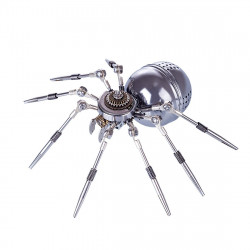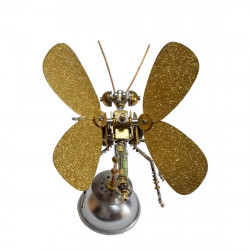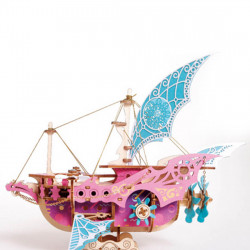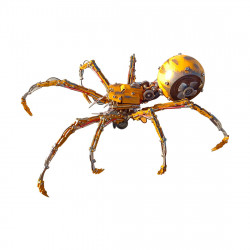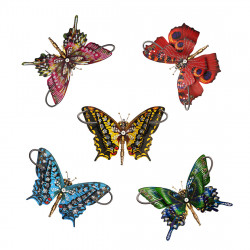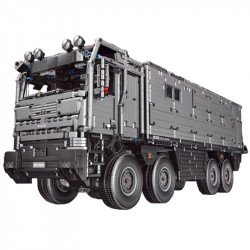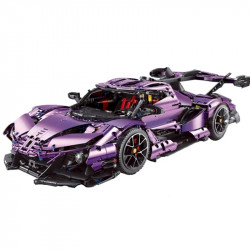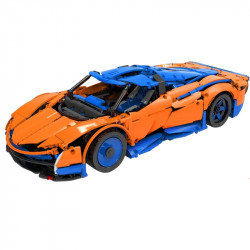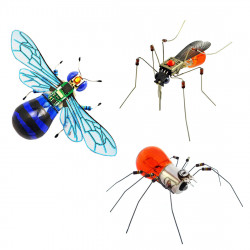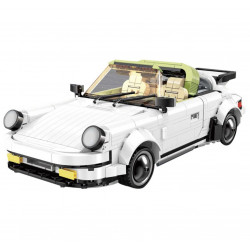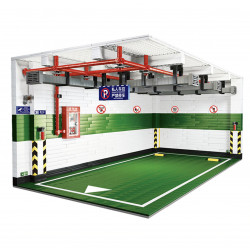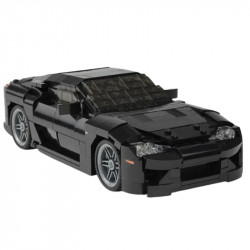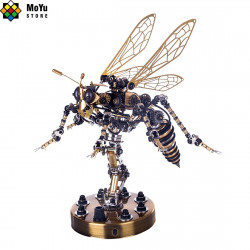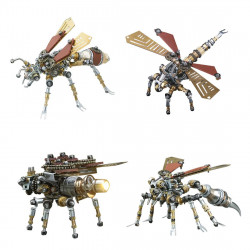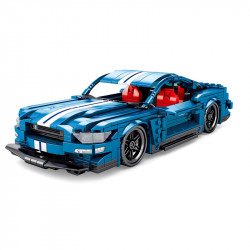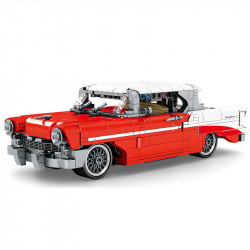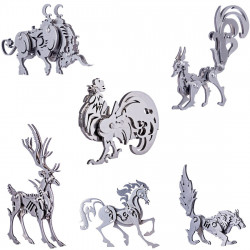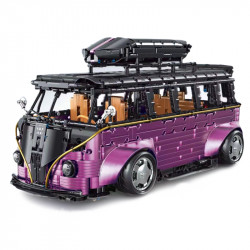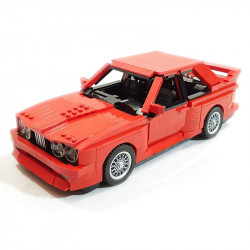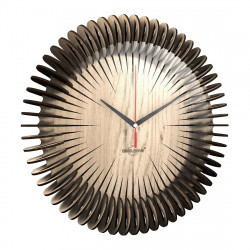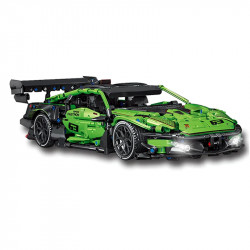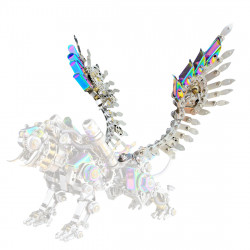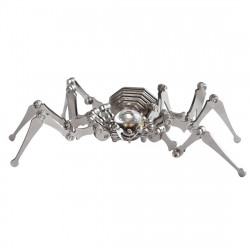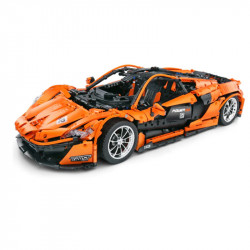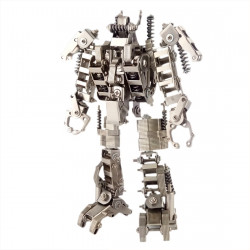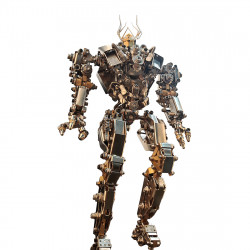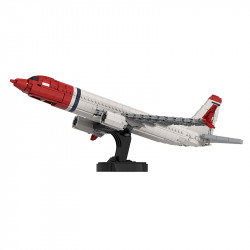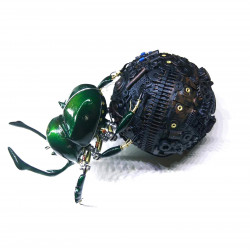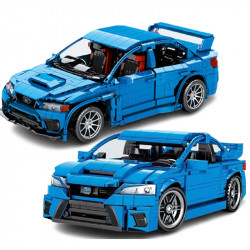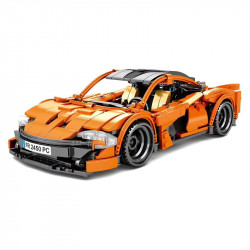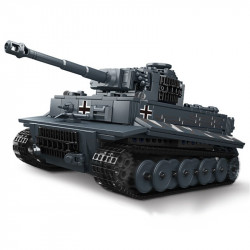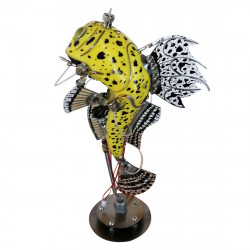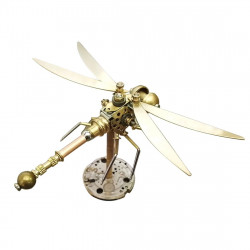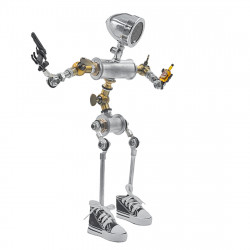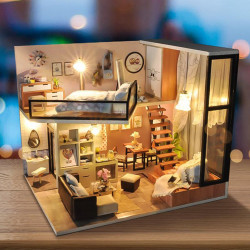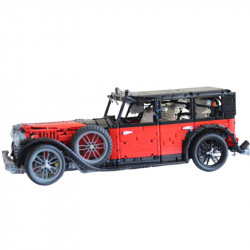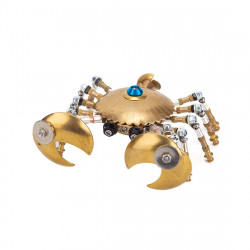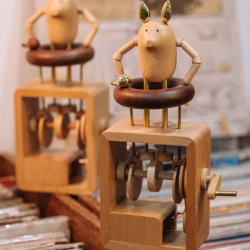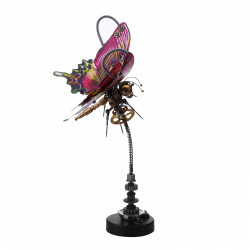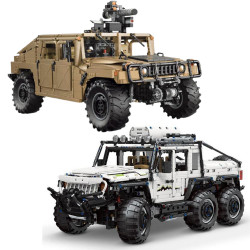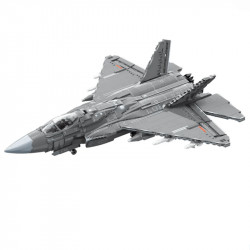Review Build: Zorii's Y-Wing Fighter

Review Build: Zorii's Y-Wing Fighter
I had the pleasure of creating this incredibly intricate and detailed Y-Wing, which has been requested for a long time. And I can assure you that the wait was worthwhile! Although I haven't been waiting as long as some of you because I haven't been creating these models for as long, I am nevertheless happy that Metal3dpuzzles had time to develop and enhance the model designs before this one was constructed. Because it wouldn't have been as entertaining or detailed.
Sure, I am a fan of Star Wars, and sure, I was among the numerous people who requested the Y-Wing. You can still enjoy the incredible execution here, though, even if you're not a fan of Star Wars or weren't expecting it. The layering that is on exhibit is beautiful and powerful. Since there is depth, there is a genuine depth to the greeblies. Some sections are nearly entirely hidden, although they extend far beneath other sections.
Furthermore, the layering is more than just two-dimensional plane stacks. Parts of one angle overlap parts of another angle at precisely the correct height. It's breathtaking.
After my most recent complicated construction, the ICONX Star Destroyer, I realized that my build evaluation had given the impression that it was daunting and should be avoided. I apologize for it. It was a challenging but doable build, and I wanted to go over every potential issue that builders might run into in detail. Perhaps I did not convey that it was still a fun and worthwhile build. This time, I want to be clear before I dive right into the review: this is an absolutely fantastic build. Them has some complex processes and hurdles, but without them, the results would not be as impressive and detailed.
Firstly, I want to describe how (and why) I did not follow the directions precisely as they were written. The fundamental idea behind my change-up is that I constructed every part of the engine nacelles (at first, I felt awful about calling them that until I looked up their names, and that's what they were named on Wookieepedia) and set them aside.
After that, I expanded and finished the cockpit part. After that, I returned and put the fighter's nacelles together. And I did all of this for [primarily] one reason: those nacelles contain a lot of space, which means there is a good chance that they will get mangled (though they did make it relatively strong, as it turns out), and I am not good at handling models gently when attempting to work on them. Thus, I constructed and set aside the top, bottom, thruster cone, rear control fins (?) and front intake of each nacelle, returning to them after completing the whole model.
After that, I want to bring up one more general point regarding this build. Take care of the pieces. There are portions of this infant that are really tiny. as well as numerous tiny folded parts. And I mean it when I say minor and minuscule. I feel so foolish for pointing out the minor folds and sections of the Star Destroyer. They weren't anything. Therefore, being careful not to drop the parts is crucial when making this gal. As much as possible, anyway. My enormous sausage fingers caused me to drop a lot of them. The majority of this build's video is pointless because the pieces vanish in my big fingers. For instance, the component (number 17) in the image below is seen resting on Lego Chewbacca's toe. Additionally, it is intended for the trim strips on its sides to be folded over and rounded at the ends. Yes. It's that specific.
Let's move on to the actual process now that we have addressed the generic review topics. It begins with a highly intricate and multi-layered portion of the main body that appears to be the bottom but is actually the top. Yes, there are freebies all the way to the bottom of this ship! I adore it! Very tiny and intricate greeblies, so enjoy the intricacy and take your time. I couldn't recommend anything as a promising approach to do anything or something to avoid doing. Focus and remember to breathe.
The following section, which starts building the upper part of the ship, is where I ran into my first confusion. It happened when I was creating section 16, namely the tiny parts that resembled pipes and were fastened to the sides. I had to pick them up and take a good look at the directions because they were too small for the steps. And I understand it correctly: if you generalize the pipe-shaping into a rectangular block, you are expected to fold-roll the pipe-like segments up to make a rectangle box with the piece's primary body side. As a result, the paint for the pipes is inside the box and is hardly visible. The only way I could understand the directions there was by doing this, which seemed like a waste of paint. Regretfully, the digital instructions are even more challenging to understand due to their resolution. Nevertheless, it should assist you in identifying what I am referring to. I believe.
The ship's top is when things start to become genuinely fascinating. When I first saw the model's aerial photos, I was thrilled—so much information. I was still unprepared, though. It's simply incredible. Get ready to add greeblies one layer at a time. as well as to manage some fragile "wiring harnesses." But first, pay attention to part 21's shape and use caution when cutting it out. One of the tiny projections on the side is attached to the attachment point, and I nearly cut the projection off as though it were a component of the triangular sprue connection.
I got my first serious scare of this construction after experiencing a little more of the greeble bliss. In part 38, I nearly broke a fold. Fold this first, being careful with the small corner strips! I made the error of attempting to create these after folding down the considerable flap. Because of this, the big flap was in the way, and I had trouble making the bends right. As a result, the entire end bent over on one side a few times, and then it started to seem like it was bending too quickly. That emotion is familiar to you. The sensation that if you bend this fold just one more time, it will disappear. However, I was fortunate. I also didn't shatter it. Naturally, I spent a few minutes wearing kid-sized gloves.
Furthermore, that was probably not my first scare, now that I think about it. When I spoke with AnimateOrange about this build, he told me about losing a part while working on the ship's top (I assure you, we are not coordinating our builds; we happened to start this on the same night). The ethereal worlds beneath and behind desks are gone. I so virtually gasped in terror every time I botched a part with my large, thick fingers. Unfortunately for AnimateOrange, they never fell over the desk, so I was luckier than they were.
After that, when I was putting the back of the main body together with component 44, I had my next epiphany. And if I hadn't remembered the intriguing item I had discovered while figuring out every component before beginning this construction, I might have concluded that the instructions contained an error. Part 44, as it turns out, had the majority of its carved patterns on the" "of the sheet instead of the top, which is what I had seen. There were just four little, etched fold lines on the side of the components sheet that faced what we typically consider to be the front.
Why is that important? One of the surfaces is identified as the etched surface in the section's instructions. And since I was already aware of this, I took that to mean the side with the etched designs. I, therefore, assumed it was instructing me to fold it all up using the inside engravings. Fortunately, I read ahead enough to become perplexed before I began to form the portion. Anyway, until I understood that the E etched marking in this instance was referring to which side was facing "up," while in the parts sheet, I was really perplexed and began to doubt my sanity. The side with all of the etched designs was not regarded as the engraved side, whereas the side with four small fold lines was. In order to avoid confusion, bear it in mind.
As you proceed, you work on extending the Y-Wing's "neck." The sausages I call fingers are primarily to blame for my difficulties attaching part 50; I smashed it while attempting to get it in position. You should be fine if you take it easy on that section. Part 54, one of the more humorously shaped sections you'll find in Metal3dpuzzles models generally, will be presented shortly after that. The portion appears to have the fringe from a pair of upscale cowboy boots. Before attaching those to component 52, the instructions advise folding them all at a 90-degree angle. Unfortunately, it is difficult to determine how to align the result because it is nearly entirely hidden in the "after" view of that join. Here is my interpretation: the folded-over fringe, which is currently attached to part 52, should, in my opinion, overlap and rest flush on the "outside" of part 53. The best overview of this region can be found in Metal3dpuzzles' 360-degree image, which supports my findings. I believe.
Once you have finished the ship's "body," you can proceed to building those insane nacelles. Additionally, since the nacelles are identical (apart from being mirrored), I will briefly review the creation process for obvious reasons. In order to avoid repeating myself throughout this section, I violated my rule not to twist tabs that could be seen. Due to cavities in the cylinder body, many of these tabs are "inside" the nacelle's cylinder but not entirely hidden. Usually, even if a tab isn't on the "outside," I would think about folding it if it were visible. But I decided to approach this one differently, and I recommend that you do the same. I went with twists for all but a few tabs because the voids made it crucial that all of the connections be robust.
The oddly wide spaces in this ship's design are something I particularly enjoy; they give it a unique look. It does, however, add interest to the formation process. Getting the upper and lower nacelle sections (parts 55, 67, 68, and 69) to be cylindrical is very difficult. It's challenging to make the thin strips connecting the front and back solid sections genuinely curve because of the part's lengthy voids. In order to get little pieces actually to bend over it, I used my fingernails to work my way down a drill bit that was slightly smaller than the finished shape. Although it took a lot of time, the finished product is worth it. Regretfully, I tried a couple of different approaches before settling on this one, which resulted in some odd-looking edges for those strips. That's life.
However, each nacelle's top and bottom are not precisely divided in half. I was initially unaware that the top segment contained a far larger portion of the entire cylinder than the bottom. The tiny cones at the back appear to have slightly more than the top section, which is nearly the opposite. To get a decent notion of the cylinder's diameter, you can utilize components 63 or 64.
However, I omitted writing about my experience with the engine-thrust-cone-thingies by writing about both cylinder parts at once. And they're a great challenge, boy. You get to do that twice. It has twists, bends, and cones. With one exception—the way the larger "fins" are attached—I like the way these assemblies turn out. This is something of a pet peeve of mine, but only because they occasionally do take this problem into consideration. They also didn't show up. The asymmetric (except tabs) component is folded in half to create the large fins (part 62). In part 61, the part is subsequently secured through pairs of slots using those two asymmetric tabs. The fact that the slots on part 61 are precisely aligned with one another instead of being somewhat offset (to account for the fact that the nature of the fold offsets the tabs on part 62) is my pet peeve. As a result, the fins are inclined slightly to the side rather than aligned with the cone when attached. In certain instances, Fascinations has considered this and adjusted the slots in other models by the smallest amount. I wish it had been done here. Instead, I brute-forced it to a "straightishness" after securing it. Which regrettably caused the pieces to loosen, causing them to now flop around a little. It makes me feel depressed. Since I've never attempted to design one of these things before and wouldn't have a chance if I did, it's obviously simple for me to provide this criticism. So don't take my grievance personally.
After the difficulty (and some irritation) of the thrust-cone insert, the cylinder's rear insert is incredibly straightforward. Once more, I put these parts aside so I could put them together later. I then skipped ahead to the construction of what I believe to be the engines' "air intakes," despite the fact that it is absurd on a spacecraft. It could be for flying in the atmosphere. I'm not sure. I hesitate to describe these as easy, but they are pretty simple. They have a semi-dome-shaped lid and a dome-shaped portion.
Furthermore, domes are never truly "easy." I will admit that the cover has its difficulties because of the metal's voids, which require caution when bending the flaps downward. However, I'm going to venture that you are at ease with domes in general if you are taking on this model.
By this time, I had finished constructing the nacelles' constituent parts. Cheers! I assumed that the cockpit and the "neck" didn't look all that difficult (comparatively). In a sense, it wasn't. However, it also presented particular challenges.
I only really came across three issues that stood out as brutal throughout the Cockpit build. First, the slots cut into part 82 make it hard to form it into a cylinder, since it just wants to collapse at the weak areas. To remedy this, I made the curve first with a drill bit, then squeezed over the folds with my pliers and rolled the components between the slots by hand. Rinse, repeat, and lather until it looks good. Connecting the cockpit's top and bottom halves was the next obstacle. Tightening the fit is really difficult, and it ultimately left a small opening. The small trim piece that goes on the nose comes last. I detest that small aspect. It's fragile, tricky to align (and maintain orientation while securing), and because I couldn't seal up the two sections of the cockpit as snugly as I desired, it was a little too small. But after some brute-force coaxing and colorful words, I got it attached.
I was then, at last, able to go back to the nacelle pieces and attach/assemble them. Make sure you keep track of which parts belong to which and attach them all on the appropriate sides if you follow my method (except for the duplicated assemblies, of course). The nacelles' proper shape is actually aided by the presence of several round components inside their overall cylinder. However, please exercise caution when handling the long, thin portions; although they are powerful, given their lack of structure, they are still susceptible to bending. It was rather difficult for me to join the "halves" of the cylinders, at least to make it tight. In the end, I used a technique I occasionally employ, which involves pinching the tab's tip sideways with my fine-tip pliers and then rolling the pliers sideways to pull the tab through the remaining portion. I next use my fingernail or the outside of a pair of tweezers to press the tab flat to finish.
I genuinely like how Fascinations made the components that fit within the cylinders so that only one tab protruded through the second lower half of the cylinder to which you attached it. This was an excellent answer to the challenging task of molding a cylinder over several tabs. The "intakes" on the nacelles were attached using a combination of tabs and slots, which I also appreciate because it made it very simple to keep the part aligned while fastening each tab.
Additionally, similar to the ICONX Star Destroyer, this ship does not have an associated holding stand. If you want to see why that's a crucial feature, check out AnimateOrange's evaluation of the Star Destroyer. Additionally, it will balance on the stand, though it's not entirely clear where the model should line up with the stand. To make sure the starfighter had even less possibility of slipping off, I naturally attached magnets to this one once again.
Therefore, even if I made a few errors, I still liked the outcome. I am aware that no matter how many photos I take of this model, I will never be able to capture its depth and complexity. The addition to the detail is not immediately apparent because there are a lot of things that are not fully visible. Nevertheless, the effect is still powerful. I compare it to some of the strange things that special effects artists use, which you would never notice but would think was "wrong" if they didn't use. That is the depth of it.
Oh, and if you're unaware of the backstory behind this starfighter's considerably more exposed mechanics, it's because, in accordance with canon, crews began simply leaving the fighter's usual "body" off during maintenance because it was so difficult to remove. I adore how intricately the Star Wars universe is developed.
I'll conclude my review with my build's videos, as usual, just for reference once more. If you can't see what I'm doing, I apologize; I still haven't figured out a good way to get the lights adjusted well. How AnimateOrange makes it look so simple is beyond me! In case you were wondering, I spent about eight hours working on this build over the course of four build sessions. Furthermore, the pre-build knocking time is not included.
